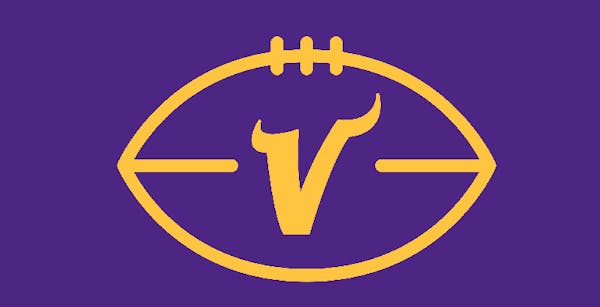By the time the Vikings drafted Kellen Mond with the 66th overall pick last Friday night, six quarterbacks had already heard their names called in the NFL draft, including Ohio State's Justin Fields, who went 11th overall to the Bears after the Vikings made at least some attempt to trade up for him.
Mond's selection tied the NFL record for the most quarterbacks taken in the first three rounds of a Super Bowl-era draft, a pick before the Texans broke it by taking Davis Mills. In all, eight quarterbacks were taken in the first three rounds of a draft that featured three straight QBs at the top for just the second time since 1971, joined the 1999 draft as the only ones to feature five QBs in the first 15 picks and became just the fourth (following 2018, 1999 and 1983) where at least five QBs were taken in the first round.
Mond's progression in Minnesota will not draw the same kind of attention as Trevor Lawrence's in Jacksonville, just as his selection did not merit the same kind of fanfare during draft weekend. But the pick, as well as the fact the Vikings thought about taking Fields in the first round, does suggest they're thinking toward the future at precisely the moment Kirk Cousins' cap number is set to cross $30 million for the first time.
Since Rick Spielman joined the Vikings in 2007, they've only selected one quarterback before the sixth round when they weren't looking for a starter. That would be Mond, whom sources said was popular enough in the organization that some had him ranked as high or higher than Fields. (The Ohio State quarterback's epilepsy raised some questions, though Fields has said he's managed the condition with medication through his career.)
The Mond pick poses no immediate threat to Cousins, and the rookie has plenty to prove before he can be considered a serious candidate to unseat the Vikings' 32-year-old starter. There are justifications for Mond's presence in Minnesota: the Vikings had no backup on the roster they could trust if Cousins were injured, and he can develop behind Cousins without the friction that might have existed if the team used a first-round pick on a QB when its starter has two fully-guaranteed years left on his deal. Mond's mobility also could benefit the Vikings under the thought a backup quarterback should provide something different than the starter and be able to create plays on his own when he hasn't received much practice operating the first-team offense.
But if the Vikings do consider a transition to Mond in a couple years, Cousins' salary — not his durability or age — could be the main reason why.
Cousins will count for 16.6 percent of the Vikings' cap space this season (with the cap dropping because of the coronavirus pandemic) and his $45 million figure could occupy more than 20 percent of it next season. Especially on a team that wants to operate with a prominent running back and keep high-dollar defensive players, that's a tough balance to maintain.
Were the Vikings to sign Cousins to a third contract after 2022, they'd pay him into his age-35 season just as they'd have to start thinking about a Justin Jefferson extension. Cousins hasn't missed a meaningful game in Minnesota, hasn't even shown up on an injury report since 2013 and has said he wants to finish his career with the Vikings. He's also talked about playing out his current deal with the Vikings, and has seemed clear-eyed about the need to win big if he's going to be with the team into his late 30s.
Though Mond's arrival hasn't raised any alarm in Cousins' camp, which knew weeks ago the Vikings could pick a quarterback, the rookie at least presents an alternative for the team to consider down the road.
He arrives during an offseason where quarterback movement has been the most prominent storyline in the league (and could continue to be, if Aaron Rodgers' issues with Packers management aren't resolved). When Cousins signed his initial three-year, $84 million deal with the Vikings, his $28 million average annual salary was the highest in the league; he's now on a deal that averages $33 million a year and ranks seventh.
The quarterback just below him (2016 No. 2 overall pick Carson Wentz) was traded this offseason. The passer two spots above him (2016 top pick Jared Goff) was also traded, and three of the other five passers above Cousins (Deshaun Watson, Russell Wilson and Rodgers) have been the subject of trade talks. Matthew Stafford (averaging $27 million per year) was traded for Goff. Jimmy Garoppolo (averaging $27.5 million per year) figures to be replaced by No. 3 overall pick Trey Lance.
While the money for top quarterbacks has never been better, the ones who don't deliver consistent playoff success are sometimes deemed not worth the investment.
As Pro Football Focus pointed out earlier this offseason, the return of middle-class QB contracts (like the one Washington gave Ryan Fitzpatrick, New Orleans gave Jameis Winston and Chicago gave Andy Dalton) can be worthwhile investments for teams that have otherwise solid rosters and aren't ready to shoulder heavy QB costs. Those passers might need everything to go right around them to make any kind of meaningful run (a la Nick Foles or Case Keenum in 2017), but they can also approximate the added value (measured by PFF in terms of wins above replacement) of more expensive options at a fraction of the cost.
Cheap quarterback contracts provide teams with a massive advantage because they facilitate greater spending on other parts of the roster, which is why so many clubs chose to look for a first-round passer that might be able to win on a cheap rookie deal. Otherwise, picks like the one the Vikings made last week represent a hedge against a big bet.
Quarterback play has arguably never been more important in the NFL, but it's rarely been more expensive. That can lead teams like the Vikings — who've gone 25-22-1 with Cousins — to a tipping point. He'll get another chance to deliver on the massive investments the team has made in him; he might need to deliver in order to receive another investment.

Live: Minnesota United at Charlotte FC. Follow on Gameview.
Jameson Taillon comes off the injured list and helps the Cubs beat the Marlins 8-3
T-wolves take NBA's best defense into series vs. Suns, but can it stop Durant-Booker-Beal trio?


